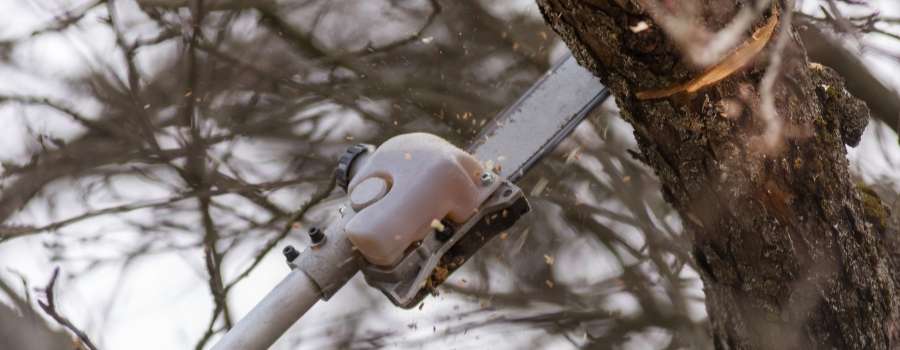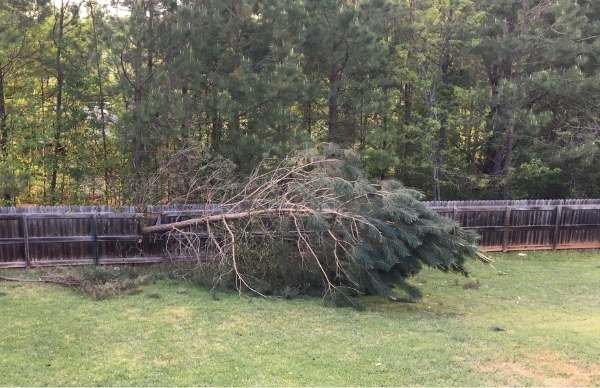
Pole saws are versatile tools that can cut down small trees with the use of a long handle. It is important to know how to safely operate one in order to get the maximum benefit out of it!
With so many lawn and garden tools available, you can quickly get a shed cluttered full of things that may never get used…you might be wondering if a pole saw is worth the price and the loss of shed space. I did a little research and here’s what I’ve found out.
What Is A Pole Saw?
In general, a pole saw is a saw on a telescoping pole that sometimes has adjustable bends to accommodate various angles for pruning tall bushes and trimming tall branches. Some models of pole saws are manual, but the most common ones today are either electric or gas-powered.
A few years ago, the town where my parents were living experienced an EF-3 tornado…they were a lot more fortunate than some, only having a medium-sized pine tree fall on a section of fence.
The tree was significant enough to need a chain saw to take off the branches and cut them down into manageable sections.
Unfortunately, my father’s chain saw needed a new chain, and since the entire city was dealing with tornado damage, getting a new chain was near impossible. We did have a pole saw handy, but the tree was beyond the recommended maximum diameter…but that doesn’t stop my dad!
Dad has a Sun Joe Pole Saw that we picked up on Amazon a few years back that works great at taking off the branches…which is what it’s designed to do…but the real test came when it was time to segment the trunk.
While it took a bit longer than using a standard chainsaw, the Sun Joe held up and made several cuts to the 8-inch trunk.

Is A Pole Saw Worth It?
If you need to trim tall hedges or cut limbs that are above your head, then using a pole saw is safer, more efficient, and quicker than using a hedge trimmer, hand saw, or ladder to reach heights.
The model we were using has a length that goes from 8.6 feet to 15 feet and an 8-inch blade that’s designed to cut thicknesses up to 7.5 inches.
This model is a plug-in model which, on one hand, can be seen as a negative but considering most work is done over your head I count this as a positive since a fuel tank would add extra weight.
Electrical power also means not dealing with a ripcord, exhaust fumes, and fewer maintenance costs. There is also a 2.7-ounce oil tank for self-lubrication.
Other models, such as the Sun Joe SWJ803E, allow you to change the angle of the saw thanks to an adjustable arm.
Electric models can either be battery operated or plug into an outlet. The battery means you’re not pulling a long extension cord across your yard, but you’re also limited to the battery’s charge. If you have a big job to do then you might have to buy multiple batteries or take breaks and charge up.
Gas models are going to pack the biggest punch and what you’ll usually see professional landscapers and tree trimmers using.
What Are The Downsides To Pole Saws?
If you are using a particularly long model that is extended to its full length, then it can become top-heavy and fatigue your arms quickly. If this is the case it is best to only work for a few minutes at a time and never directly over your head.
While the lack of a fuel tank in electric models does cut down on the overall weight of the saw, the blade end is significantly heavier than the handle end, making usage quite fatiguing after a while.
Gas models will be a little heavier since they have to accommodate a fuel tank and fuel, and you’ll need to have spare fuel on hand unless you use running out of gas as an excuse to take a break to run down to the gas station. Gas machines put out noxious fumes that, if you’re like me, can make you lightheaded and nauseous.
Manual models are generally lighter, but also require, well…more manual work. Similar to hand saws, manual models can also bind up when they get dull or you try to cut through particularly hardwoods.
Are Pole Saws Easy To Use?
When used properly, a pole saw relies on gravity to do most of the work. You position the blade on top of the branch you want to cut, power it up, and guide the saw through the cut.
Pruning and shaping trees can be a little more cumbersome since you’ll be holding more of the weight of the machine. Taking breaks before you get tired will mean cutting branches and pruning trees will be safe and simple work.
Many models have telescoping poles that can go from 6 feet to 10 feet, making getting up to higher branches easier. Just remember, the longer you extend the pole the more cumbersome and fiddly the weight distribution becomes so stay in your comfort zone.

How Do I Take Care Of A Pole Saw?
Pole saws are much easier to maintain than chainsaws. Just be sure that when in use you oil the blade and guide bar once in a while, keep it well-lubricated when not being used, store it properly so there is no rusting or corrosion. When lubricating your pole saw take care to avoid contact with eyes or skin since oil can be harmful.
- Electric and gas models will have a small oil tank or reservoir that will need to be
- Just like a regular chain saw, remember to loosen the chain after using and tighten it before using it.
- Look for damage to the pole and casings of the blade and motor. If it’s a gas model also check the filters.
- These machines are vibrating thousands of times per minute, so check for loose parts, screws, and bolts. Tighten the ones that need it.
- You spent good money on your tools, clean them off when you’re done using them. It’ll help you give the saw a close look for damage and leaks and to see if the blade needs sharpening/replacing.
- Make sure electric models don’t have exposed wires or splitting in the cover. Remember to check the extension cord too!
- If there is damage to the chain, replace it. If not, remember to periodically sharpen. Sharper blades make cleaner and quicker cuts.
Are Pole Saws Safe?
The best way to stay safe when using pole saws is to avoid over-exertion, keep your machine clean and in good working order. Longer poles are harder to maneuver so don’t extend them all the way.
Pole saws come in three main types that get slightly more dangerous…but as a whole are still one of the safest tools you can use to trim trees if used properly:
- Electric
- Manual
- Gas
Electric Pole Saws
These models are extremely safe if you keep them away from water and follow the guidelines for use, care, and maintenance above. The main hazard to be cautious of when using these is the extension cord. Make sure that it is out of the way and not coiled near your feet.
Manual
Manual models can be more dangerous because they require manual effort to work so it’s best to avoid using these while tired or drunk! If you do feel yourself losing control of your grip on the saw, let go.
Gas
These models are the most dangerous because they have spinning blades that can easily cut through skin or clothes without much work at all. You should also avoid using these in enclosed spaces since gas fumes are highly noxious and will make you lightheaded after a while due to a lack of oxygen. Always remember to stay alert when working with a gas pole saw.
Just like a regular chain saw, remember to keep your limbs out of the guide bar and blade areas! You could lose a finger or limb if you’re not careful. Be sure that the machine is properly ventilated so there are no fumes from leaking oil or fuel. Keep children away from it since these machines can be dangerous if not used properly.
The handle has a built-in safety toggle, so the power trigger won’t work until the toggle is pressed and the saw will instantly stop if you lose your grip. Since branches will be falling around you, safety glasses…and possibly a face shield, are a must. As always, wear proper gloves and, if using a gas model, a respirator to filter the air you’re breathing in.
Since doing anything above your head can wear you out really quickly, take frequent breaks so your muscles don’t get fatigued. I don’t want to sound like a mama bird here, but it wouldn’t be a bad idea to wear a hard hat or bump cap.
There will be falling debris, including large chunks of wood that may have a pointed end depending on the cut angle. You might also lose your grip and drop the saw. Even if the chain stops as it falls, it’s a saw falling towards your head…it’s sharp and heavy!
A Few More Safety Tips When Using Pole Saws:
- Aside from the protective equipment mentioned above, make sure the area you’re cutting in a clear and open. This will help cut down on branches and debris bouncing around unpredictably as they fall…think of the “Plinko” game from ‘The Price is Right.”
- Don’t cut large branches in one piece. Cut into segments small enough that, if they do happen to fall on you, will be less likely to hurt you.
- Don’t stand directly under what you’re cutting. Standing at an angle will cut down on falling branches hitting you and will give you a better view of your cuts.
- You should try to cut a notch or groove into the top of the branch before you go all the way through. This will give you a cleaner cut and help guide the blade.
- It should go without saying, but DON’T CUT NEAR POWER LINES!

Final Thoughts
While pole saws are a fairly inexpensive tool and easy to operate, they seem like they’re not in a homeowner’s arsenal that often. Sure, some of us might not have a large number of trees or hedges to maintain, but even having just a few of either might warrant picking one of these up.
On a side note, if you have several hedges or bushes to trim, I recommend getting a dedicated hedge trimmer. While you should always use tools for their intended purpose, I think using a pole saw on a hedge or two is perfectly fine.
That being said, I really think an electric model (plug-in style) is the way to go. Sure, you’ll likely need a long extension cord (something I feel should be in every garage, anyways) but you’ll have a steady supply of power that you never have to charge (battery) or fill up (fuel.)
